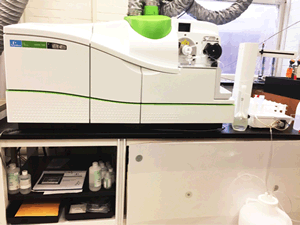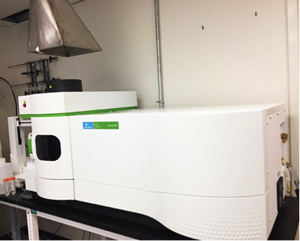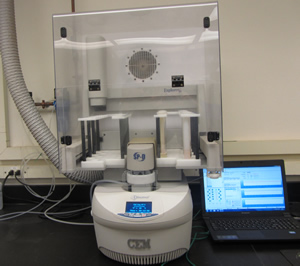PerkinElmer – Models NexION 350D (ICP-MS) and Optima 8300 (ICP-OES)
The Microanalysis lab is well equipped with an ICP-MS and an ICP-OES from PerkinElmer that excel at determining the major, minor and trace concentrations of most of the elements of the periodic table.
Inductively Coupled Plasma is the source of producing excited atoms/ions for both the instruments. It is generated by coupling the energy produced by a radiofrequency generator to a suitable gas usually Argon. A high electric current is passed to the RF coil which generates oscillating magnetic field around the coils. A spark is produced from a Tesla coil which initiates the ionization of Argon gas and produces seed electrons. These electrons are further accelerated on interaction with the oscillating magnetic field and gain sufficient energy to ionize more argon atoms. This process continues until an equilibrium is reached between the rate of formation of ions and the rate of recombination of electrons and positively charged Argon ions. The end product is the formation of a high temperature plasma that can desolvate, vaporize, atomize and ionize the sample. The plasma is the source of ionization for ICP-MS and also the source of excitation for ICP-OES.
The major difference between ICP-MS and ICP-OES is that the former one measures m/z ratio of elements while the latter collects the wavelength of light emitted by the excited species (elements/ions) to characterize elements. In an ICP-MS, the ions are focused by ion-lens and directed to a four rod assembly (quadrupole) which separates them on the basis of m/z ratio. The NexION 350D ICP-MS (Figure 1) has a linear dynamic range of 10 orders of magnitude and a detection limit down to parts per trillion level.

The PerkinElmer Optima 8300 (Figure 2) is a simultaneous ICP-OES system and has an echelle based polychromator that utilizes two Segmented –array Charge Couple Device (SCD) for wavelength detection. ICP-MS is one to two orders of magnitude more sensitive than ICP-OES.

Sample Preparation
The single most crucial aspect of ICP-MS analysis is sample preparation. Since only small amounts of sample are used, homogeneity is of utmost importance. Total dissolved solids may not be more than a maximum of 0.25%, and in most real life applications, samples must be drastically diluted. We typically like to keep most analyte concentrations at or below 80 ppb.
Sample amounts of 1 to 2 mg are usually sufficient. But that depends entirely on the expected analyte concentrations.
Protein samples present a particularly difficult challenge, since we often get only single digit µL liquid samples, in buffers that might themselves carry interfering species, such as P, S, Ca, Cl and organics. In such cases we would like to see sufficient material to perform a digestion, which also eliminates most organic components that might cause variability in sample transport, such as varying viscosity and surface tension.
Our digestions are done in a Discover SPD 80 (CEM Corporation) Microwave Digestion System.

The high purity acid cocktails used depend on the analytes in the sample. In rare instances we are face with acid insoluble materials, such as metallic ruthenium, which requires a NaOH/Na2O2 fusion.
In most instances we need to do two dilution steps from the digester to the final sample presented to the instrument. We are keenly aware that each dilution represents an error amplification and exercise great care in sample preparation.
DETECTION LIMITS of the NexION 350D (pdf)
DETECTION LIMITS of the Optima 8300 (pdf)
Potential users are invited to visit the laboratory for consultations, preferably between 8:30 am and 10:00 am.